THE ROOFING SLATES OF DINORWIC [DINORWIG].
700 ACRES OF QUARRY.
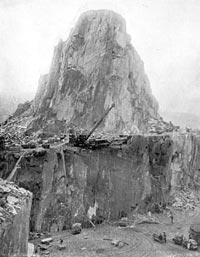 THOUSANDS of holiday visitors every year coach round Snowdon from Carnarvon [Caernarfon],
and gaze with astonishment at the terraced precipices of Elidir, opposite
Llanberis. Very few, however, realise the full significance of the mighty
Dinorwic [Dinorwig] or Port Dinorwic [Y Felinheli] slate quarry which has carved
its way into the mountain side.
THOUSANDS of holiday visitors every year coach round Snowdon from Carnarvon [Caernarfon],
and gaze with astonishment at the terraced precipices of Elidir, opposite
Llanberis. Very few, however, realise the full significance of the mighty
Dinorwic [Dinorwig] or Port Dinorwic [Y Felinheli] slate quarry which has carved
its way into the mountain side.
Yet this quarry is famous the world over for the slate which it produces.
No form of economy is more delusive, or more expensive in the long run, than
to roof a house with inferior material, however cheap in the beginning.
Fortunately, Nature herself has provided an ideal material for the
purpose-namely, slate. This stone has been hardened for centuries in the solid
earth by incalculable pressure, which has rendered it extraordinarily hard-far
harder than any substance, like brick or pottery, which can be produced
artificially by the action of fire in kilns. Geologically slate belongs to fie
oldest systems in the Primary division-pre-Cambrian, Cambrian, Ordovician, and
so forth-and is thus among the oldest stones in existence. Its age is shown by
the fact that it contains no fossils. Moreover, unlike all other stone, it is
capable of being split longitudinally into smooth, flat layers, each of which
retains the hardness of the original blocks.
WELSH SLATE THE BEST
There is no slate in the world which possesses the quality of hardness in so
high a degree as that of Wales. If corroboration were required, it might be
found in the significant fact that geologists have given to the oldest and
hardest of slate the adjective Cambrian, Cambria being the ancient Roman name of
Wales. It is in the north-west corner of Wales that the best slate is found. The
observant traveller between Bangor and Carnarvon [Caernarfon], as he passes
along the Menai Straits, will see everywhere slate in practical use, not only
for roofs, but for nag-stones, boundary walls, gravestones, doorsteps, and the
like. Half-way in the journey he will come to the small town of Port Dinorwic [Y
Felinheli], which has come into existence as a harbour for the great slate
quarry.
QUALITY OF DINORWIC [DINORWIG] SLATE.
Just as slate stands pre-eminent among roof materials, so Dinorwic [Dinorwig]
slate is unsurpassed throughout the world in the excellence of its quality. The
quarry is the largest in the world, and its slate is the hardest and most
durable. It has every possible colour - blueish, reddish, grey, sea-green,
&c.- and the various qualities (e.g., Best and Seconds Old Quarry, Best and
Seconds New Quarry, Best and Seconds Green and Wrinkled, Best and Seconds
Mottled, etc., etc ) simply cannot wear out. Quite recently a Blackburn slater
stripped the roof from a house which was known to have stood unaltered for a
hundred years. Dinorwic [Dinorwig] slate had been used, and he found that they
were absolutely as good as new. They were immediately used for another
horse-which also they will assuredly outlast.
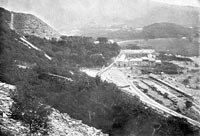 This intense hardness is due partly to the tremendous natural pressure which
has acted for countless centuries upon the lowest rock-strata and partly also to
the bands of igneous rock which have been forced up through the slate beds.
Obviously the intense heat of these volcanic neighbours has submitted the slate
to an ordeal to which ordinary heat is a mere nothing. Another important
advantage is that the slate is absolutely impervious to the corrosive action of
acids in the atmosphere. An example of this is the fact that the largest glass
manufacturers in the world, Messrs. Pilkington, of St. Helens, have found it
absolutely necessary to roof their works with Dinorwic [Dinorwig] slate. No
other material can withstand the gases which are generated by glass-working, and
the many chemical manufactories in the town. Yet Dinorwic [Dinorwig] or Port
Dinorwic [Y Felinheli] slate, as it is also called, withstands this severe
strain with complete equanimity.
This intense hardness is due partly to the tremendous natural pressure which
has acted for countless centuries upon the lowest rock-strata and partly also to
the bands of igneous rock which have been forced up through the slate beds.
Obviously the intense heat of these volcanic neighbours has submitted the slate
to an ordeal to which ordinary heat is a mere nothing. Another important
advantage is that the slate is absolutely impervious to the corrosive action of
acids in the atmosphere. An example of this is the fact that the largest glass
manufacturers in the world, Messrs. Pilkington, of St. Helens, have found it
absolutely necessary to roof their works with Dinorwic [Dinorwig] slate. No
other material can withstand the gases which are generated by glass-working, and
the many chemical manufactories in the town. Yet Dinorwic [Dinorwig] or Port
Dinorwic [Y Felinheli] slate, as it is also called, withstands this severe
strain with complete equanimity.
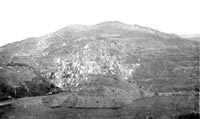 Similarly the Mersey Docks and Harbour Board always specify Dinorwic [Dinorwig]
slate for their warehouses and sheds. the surface of Dinorwic [Dinorwig] slate
is so hard that no damp can find ingress. Tested by chemical analysis, it
emerges as the finest slate the world produces. A rough experiment emphasises
this point. If overnight you affix a ring of putty to a Dinorwic [Dinorwig]
slate, and fill the circle with water, no moisture will be found on the
underside in the morning; in the case of inferior slate the water will gradually
percolate through the pores till it readies the lower surface.
Similarly the Mersey Docks and Harbour Board always specify Dinorwic [Dinorwig]
slate for their warehouses and sheds. the surface of Dinorwic [Dinorwig] slate
is so hard that no damp can find ingress. Tested by chemical analysis, it
emerges as the finest slate the world produces. A rough experiment emphasises
this point. If overnight you affix a ring of putty to a Dinorwic [Dinorwig]
slate, and fill the circle with water, no moisture will be found on the
underside in the morning; in the case of inferior slate the water will gradually
percolate through the pores till it readies the lower surface.
THE QUARRY ITSELF.
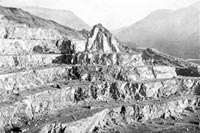 Visitors to North Wales cannot spend a more interesting day anywhere than at
Dinorwic [Dinorwig]. The quarry itself is seven miles inland from the Menai
Straits. It is cut into the south side of the mountain called Elidir, which
overlooks the village of Llanberis, and confronts the great mass of Snowdon
across the two lakes, Peris and Padarn. It has been worked continuously for a
century and-a-half, during which millions of tons of slate have been removed.
Visitors to North Wales cannot spend a more interesting day anywhere than at
Dinorwic [Dinorwig]. The quarry itself is seven miles inland from the Menai
Straits. It is cut into the south side of the mountain called Elidir, which
overlooks the village of Llanberis, and confronts the great mass of Snowdon
across the two lakes, Peris and Padarn. It has been worked continuously for a
century and-a-half, during which millions of tons of slate have been removed.
THE DINORWIC [DINORWIG] RAILWAY SYSTEM.
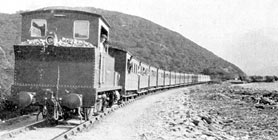 When a sufficient number of slates have accumulated and are then ready for
transport, they are placed in small trucks running upon a narrow gauge railway
which ramifies into every corner of the great quarry. There are upwards of 50
miles of this railway, and thousands of trucks are used. They are hauled along
the terraces to the nearest incline by light locomotives, of which there are
some two dozen in the workings. Down the inclines-some of which have a gradient
of one in one! - there is a double line. The trucks are securely attached to an
endless steel rope with a breaking strain of nearly 30 tons which winds round
two great drums in a shelter at the top. the trucks, going down by force of
gravity, haul up "empties," and so the circle is completed. Each
gradient is complete in itself with junctions which communicate with subsidiary
terraces right and left. Viewed for a distance they give the impression of a
series of ladders, each beginning and terminating in a small level space where
the trucks are transferred from one rope to another. Each series of such
gradients ends on a sort of main line which runs the entire length of the lowest
quarry level, and communicates with what may be called the trunk line from the
quarry to the quays of Port Dinorwic [Y Felinheli].
When a sufficient number of slates have accumulated and are then ready for
transport, they are placed in small trucks running upon a narrow gauge railway
which ramifies into every corner of the great quarry. There are upwards of 50
miles of this railway, and thousands of trucks are used. They are hauled along
the terraces to the nearest incline by light locomotives, of which there are
some two dozen in the workings. Down the inclines-some of which have a gradient
of one in one! - there is a double line. The trucks are securely attached to an
endless steel rope with a breaking strain of nearly 30 tons which winds round
two great drums in a shelter at the top. the trucks, going down by force of
gravity, haul up "empties," and so the circle is completed. Each
gradient is complete in itself with junctions which communicate with subsidiary
terraces right and left. Viewed for a distance they give the impression of a
series of ladders, each beginning and terminating in a small level space where
the trucks are transferred from one rope to another. Each series of such
gradients ends on a sort of main line which runs the entire length of the lowest
quarry level, and communicates with what may be called the trunk line from the
quarry to the quays of Port Dinorwic [Y Felinheli].
NARROW GAUGE AND BROAD GAUGE.
The slates having arrived at the lowest level are examined, classified, and
credited to the particular quarrymen who have delivered them. At this point an
obvious problem meets with a most ingenious solution. Obviously the narrow
railway required for the gradients and tunnels of the quarry system is unsuited
to a seven-mile line on open and fairly level country. the quarry engineers have
therefore built their trunk line with a four-foot gauge, and prepared trucks
which each carry four of the smaller trucks required for quarry work. The
smaller trucks are run on their own line to the very edge of the terminus of the
trunk line, and pushed on to the larger trucks waiting at a lower level to
receive them. They are securely held in position on the larger trucks by an
automatic device. A complete train of these larger trucks, which may carry
altogether 100 tons of slate, is then dispatched to Port Dinorwic [Y Felinheli]
for shipment.
UNDAUNTED ENGINEERING.
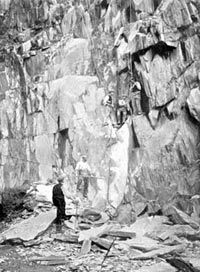 The terminus of this trunk lines is not quite the end of the journey. There
is still a quarter of a mile of very steep descent to the harbour. The small
trucks are, therefore, wheeled off the larger trucks, and once again separately
attached to an endless chain which escorts them to fit quay, where the slates
are stored close to the ships.
The terminus of this trunk lines is not quite the end of the journey. There
is still a quarter of a mile of very steep descent to the harbour. The small
trucks are, therefore, wheeled off the larger trucks, and once again separately
attached to an endless chain which escorts them to fit quay, where the slates
are stored close to the ships.
Sir Charles Assheton-Smith comes of a long line of ancestors who have held
large tracts of land in Carnarvonshire [Caernarfonshire] since the time of
Charles's II., and resides on the beautiful wooded estate of Vaynol, close to
the Menai Street and the Britannia Tubular Bridge which carries the Holyhead
line.
THE HARBOUR AND WHARVES.
Port Dinorwic [Y Felinheli] itself nestles in a tiny inlet opening out of the
Strait. Its old name is Velinheli, which means "Saltwater Mill," and
derives from an old mill which stood on the inlet and used the ebb and How of
the tide to turn its wheels. The inlet was lengthened and widened some ten years
ago to admit the fleet belonging to the quarry. It is entered by a lock, and
there is a dry dock for repairs. At the head is the private electric light and
power station which supplies not only the wharves, but also the village of Port
Dinorwic [Y Felinheli], which has grown out of the needs of the great quarry
enterprise. The harbour has a complete repairing equipment, in charge of a
competent engineer.
THE OVERSEAS TRAFFIC.
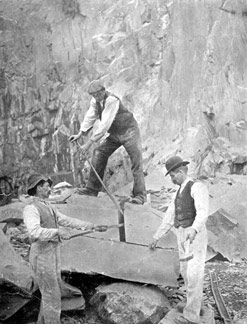 Day after day the steamers leave Port Dinorwic [Y Felinheli] carrying slates
to Liverpool and all the ports of the British Isles, especially Lancashire,
Scotland and the East Coast. From Liverpool the slates are sent all over the
world - to Germany, Austria, South America, India, Australia and the Cape. The
present writer saw a consignment of 200 tons ready for shipment to Sydney via
Liverpool. On an average some 100,000 tons annually leave the harbour of Port
Dinorwic [Y Felinheli].
Day after day the steamers leave Port Dinorwic [Y Felinheli] carrying slates
to Liverpool and all the ports of the British Isles, especially Lancashire,
Scotland and the East Coast. From Liverpool the slates are sent all over the
world - to Germany, Austria, South America, India, Australia and the Cape. The
present writer saw a consignment of 200 tons ready for shipment to Sydney via
Liverpool. On an average some 100,000 tons annually leave the harbour of Port
Dinorwic [Y Felinheli].
THE QUARRYMEN.
More than 3,000 men are employed in the quarry and at the harbour. Owing in
large measure to the generous interest taken in them by Sir Charles and Lady
Assheton-Smith, the relations between them are cordial in the extreme. It is
actually twenty-five years since any dispute has occurred. When we remember the
acute controversies to which industrial revolutions have given rise in that
time, this fact is sufficiently remarkable. The men grow old in the service, and
it is no uncommon thing to find a man of over seventy-five years still at work,
hale and hearty. In many cases, too, the trade is hereditary through many
generations.
Quarrying is done and paid for by the piece. Two men join together as
"partners," and receive a definite area of rock on which to work. This
allotment is called a "bargain." It is always 21 ft long, and ranges
up to a height of 75 ft. One of the partners works at the face of the rock
blasting and preparing the rough blocks which are loosened ; the other receives
it in their common shed and finishes oft the work. The two partners hire a third
man, known as their journeyman, a youth who has served a kind of apprenticeship
of about two years. Every two weeks the slate produced from each bargain is
calculated and paid for, the partners sharing, and jointly remunerating their
journeyman. Payment is made at so much per 100 slates, according to their size,
together with a certain poundage according to the quality of the slates
produced.
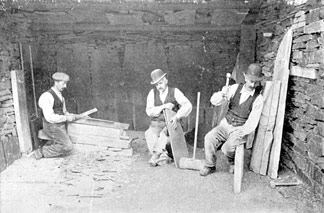 Most of the men live on the proprietor's land in Llanberis, Ebenezer, and
other villages. They are conveyed to the quarry by special carriages on the
quarry line, for which they pay a nominal sum. In former days they propelled
themselves along the rail on hand-worked velocipedes, turn and turn about-a
method both hard and dangerous to health. Some 300 men have their homes in
Anglesey; for these men Sir Charles has erected barracks in which they can live
while at work for the nominal charge of one shilling per annum.
Most of the men live on the proprietor's land in Llanberis, Ebenezer, and
other villages. They are conveyed to the quarry by special carriages on the
quarry line, for which they pay a nominal sum. In former days they propelled
themselves along the rail on hand-worked velocipedes, turn and turn about-a
method both hard and dangerous to health. Some 300 men have their homes in
Anglesey; for these men Sir Charles has erected barracks in which they can live
while at work for the nominal charge of one shilling per annum.
Hours are from 7 a.m. to 5.30 in summer, and in winter from 8 a.m. to 4 p.m.,
with an hour for dinner, but the blasting intervals add up to a considerable
further period of rest. There are 23 working days in each month, the Saturdays
following the monthly pay-days being free. Other recognised holidays are Good
Friday, Easter Saturday, Easter Monday, Whit Monday, Harvest Festival, and
Christmas Day.
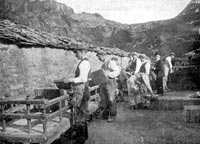 Serious accidents are remarkably few, and the majority of accidents which
occur are of the nature of small cuts and bruises from splinters of rocks. Sir
Charles Assheton-Smith provides a completely furnished hospital, which is free
to all his employees. There is a highly-qualified surgeon with a staff of
nurses, but it is satisfactory to learn that the in-patients are practically
never numerous enough to occupy the whole accommodation. There are nearly a
hundred pensions of £13 per annum, which are allocated to the deserving cases
as they fall vacant. But the work and the climate are so healthy, the men so
thrifty and contented in the mass, that both pensions and hospital are more than
adequate.
Serious accidents are remarkably few, and the majority of accidents which
occur are of the nature of small cuts and bruises from splinters of rocks. Sir
Charles Assheton-Smith provides a completely furnished hospital, which is free
to all his employees. There is a highly-qualified surgeon with a staff of
nurses, but it is satisfactory to learn that the in-patients are practically
never numerous enough to occupy the whole accommodation. There are nearly a
hundred pensions of £13 per annum, which are allocated to the deserving cases
as they fall vacant. But the work and the climate are so healthy, the men so
thrifty and contented in the mass, that both pensions and hospital are more than
adequate.
The whole face of Elidir mountain is carved into terraces connected by steep
gradients, which give access from the lake level to the topmost workings, some
1,800 feet above the lake. Not even the purist in literary style could gainsay
the propriety of describing the quarry as colossal. As the visitor is conveyed
by the light railway round the base of the mountain, cutting after cutting,
precipice after precipice comes into his view. Cavernous recesses cut into the
heart of the rock, and an apparently endless series of terraces scar the grey
background of the hillside.
Even from the vantage ground of a terrace half-way up the quarry the highest
workings are out of sight ; from no spot can one see all the cuttings which have
been quarried into the wide curve of the mountain side. The total area of the
workings is no less than seven hundred acres.
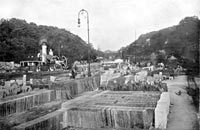 The story of the slate from the moment of its removal from the solid rock to
its shipment in one of the quarry's steamers at Port Dinorwic [Y Felinheli] is
one of absorbing interest The first step is to blast the rock and detach
fragments of suitable size for working. This blasting requires great skill and
experience. If the explosion is too violent the slate will be shivered to atoms:
the charge must be carefully calculated and inserted in such a way as to detach
the required portion. The hole into which the charge is inserted is made by a
rod called a rock-drill, worked by steam or by compressed air, and capable of
drilling a hole seven yards deep.
The story of the slate from the moment of its removal from the solid rock to
its shipment in one of the quarry's steamers at Port Dinorwic [Y Felinheli] is
one of absorbing interest The first step is to blast the rock and detach
fragments of suitable size for working. This blasting requires great skill and
experience. If the explosion is too violent the slate will be shivered to atoms:
the charge must be carefully calculated and inserted in such a way as to detach
the required portion. The hole into which the charge is inserted is made by a
rod called a rock-drill, worked by steam or by compressed air, and capable of
drilling a hole seven yards deep.
BLASTING PRECAUTIONS.
Rigid regulations govern the blasting operations. They must be carried out at
fixed times and simultaneously at all the workings. At the appointed hour a
steam whistle sounds so as to be audible all over the quarry. Immediately all
the men, except those who are to fire the trains of powder, retire to specially
constructed shelters, which are absolutely proof against any rock which might be
shot into the air. At a second signal the fuses are fired, and the remaining men
join their comrades. A period of profound silence ensues, and then all the
quarry booms and thunders with a series of explosions. Five minutes after the
whistle blows again, and the men return to work on the detached masses of slate.
Each party is required to watch its own blast; and should any charge have failed
to explode, a signal is given, and all men in the vicinity are ordered to remain
in shelter for a full half-hour. If is frequently necessary to blast away
outcrops of useless rock, such as granite. Then more powerful explosives are
used, such as dynamite and nitro-glycerine. Of gunpowder alone the almost
incredible quantity of 90 tons is used annually in ordinary blasting.
SPLITTING AND TRIMMING.
 Two processes are followed in working the rough blocks of slate-one by
machinery, one by hand. the finest qualities are so amazingly hard that
machinery is useless; no saw would be strong enough and the edges of the stone
would be chipped and splintered. Hence such slates are worked by hand with a
chisel and hammer. There is something almost uncanny in the way in which the
slates are split into layers of required thickness. The chisel is placed at any
point in the edge of the slate, and after one or two light taps of the hammer,
an even crack appears. the two layers are then gently pressed apart with their
new surfaces absolutely smooth and even. It is actually possible to divide thus
a slab one inch thick into sixteen separate slates. In practice, however, no
slates are made less than 1/6 inch thick. The quarryman's skill consists in
splitting in such a way as to avoid waste and to make the slates as large as
possible up to an ordinary maximum of 24 inches by 14.
Two processes are followed in working the rough blocks of slate-one by
machinery, one by hand. the finest qualities are so amazingly hard that
machinery is useless; no saw would be strong enough and the edges of the stone
would be chipped and splintered. Hence such slates are worked by hand with a
chisel and hammer. There is something almost uncanny in the way in which the
slates are split into layers of required thickness. The chisel is placed at any
point in the edge of the slate, and after one or two light taps of the hammer,
an even crack appears. the two layers are then gently pressed apart with their
new surfaces absolutely smooth and even. It is actually possible to divide thus
a slab one inch thick into sixteen separate slates. In practice, however, no
slates are made less than 1/6 inch thick. The quarryman's skill consists in
splitting in such a way as to avoid waste and to make the slates as large as
possible up to an ordinary maximum of 24 inches by 14.
The trimming is done by placing the slate upon a sharp edge, and breaking off
protuberances by short, sharp strokes with a kind of knife blade.
Cutting by machinery is a more economical method in the case of suitable
material. For this purpose circular saws are used. the work is accomplished with
greater accuracy and considerably less wastage. About half-way up the quarry
there is a large shed which contains some thirty of these saws driven by a
60-horse-power motor. For this and two other similar motors the power is
obtained from the North Wales Electric Power Company. Three wires carry a 10,000
volt current to the quarry, where it is reduced to 500 volts and distributed
round the upper parts of the workings, where water power is not attainable.
Source: Slate Trades Journal, December 1912